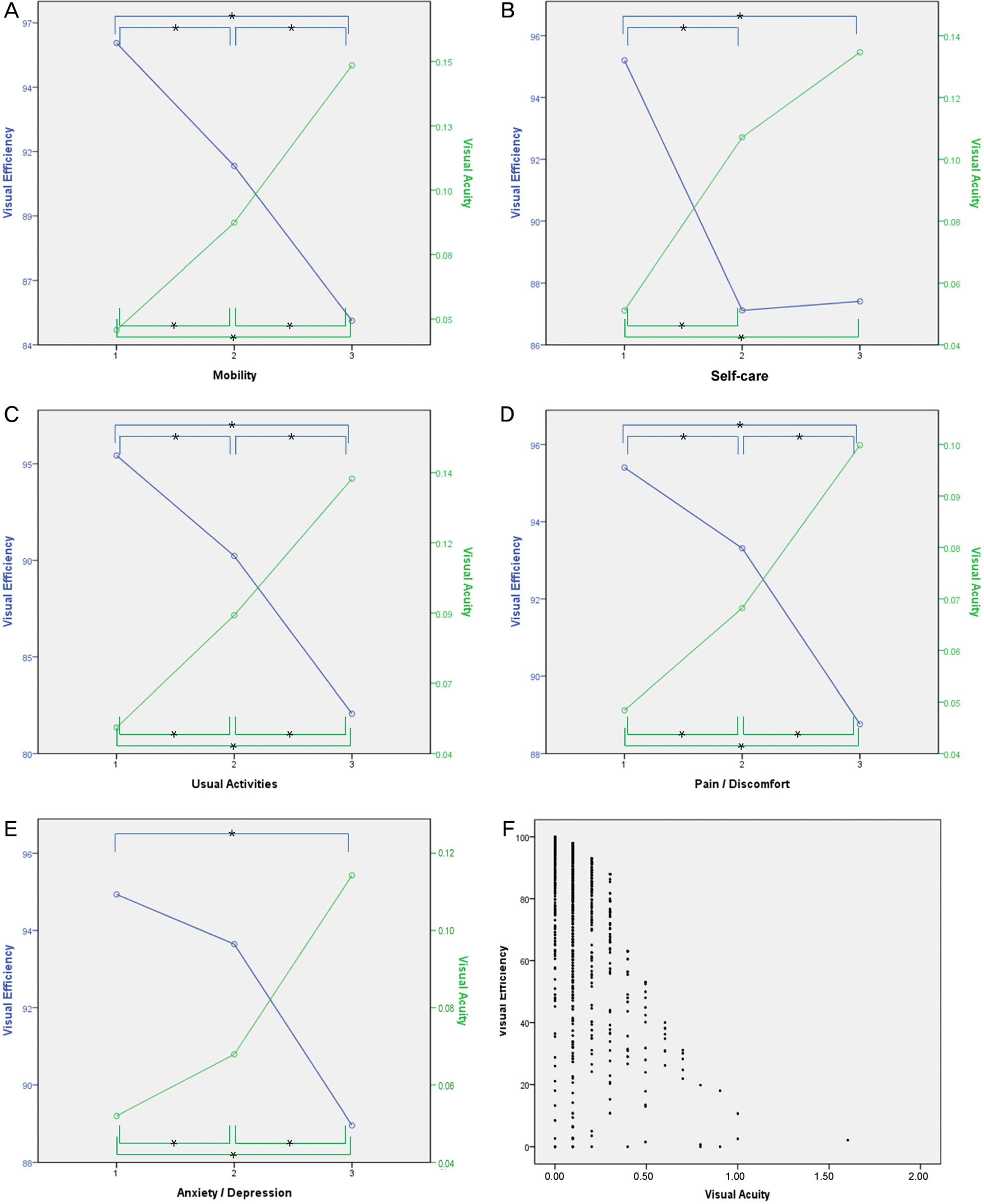J Korean Ophthalmol Soc.
2016 Mar;57(3):485-491. 10.3341/jkos.2016.57.3.485.
Quality of Life and Visual Efficiency: fifth Korea National Health and Nutrition Examination Survey
- Affiliations
-
- 1Department of Ophthalmology, Yonsei University Wonju College of Medicine, Wonju, Korea. bswhitey@hanmail.net
- KMID: 2213251
- DOI: http://doi.org/10.3341/jkos.2016.57.3.485
Abstract
- PURPOSE
To analyze the association of visual efficiency and quality of life using data from the fifth Korea National Health and Nutrition Examination Survey (KNHANES V).
METHODS
The present study included 5,244 glaucoma or glaucoma suspect subjects who completed a visual acuity test, visual field test and health-related questionnaire from the KNHANES V. Visual efficiency was calculated using best corrected visual acuity and visual field test. Quality of life was assessed with EuroQoL 5D (EQ-5D). Visual efficiency was compared with best corrected vision of the better eye to evaluate the relationship with quality of life. One-way analysis of variance (ANOVA) and partial correlations analysis were used to analyze the associations between factors.
RESULTS
Both visual efficiency and best corrected visual acuity of the better eye were significantly different with all EQ-5D parameters (p < 0.005). After controlling for age, gender, income, education, spouse and house ownership, visual efficiency showed a positive correlation coefficient of +0.040 (p = 0.006) with the quality of life and the best corrected visual acuity of the better eye showed negative correlation coefficient of -0.044 (p = 0.002) with the quality of life.
CONCLUSIONS
Visual efficiency was associated with the quality of life. Not only visual acuity but also visual efficiency would be a valuable parameter when considering the quality of life. Further studies are needed to evaluate non-glaucomatous populations.
Keyword
MeSH Terms
Figure
Cited by 1 articles
-
The Preference of Lid Height and Laterality with an Ocular Prosthesis in Korean Patients
Hyun Uk Shin, Long Yu Jin, Ji Young Suh, Hee Bae Ahn
J Korean Ophthalmol Soc. 2019;60(4):308-314. doi: 10.3341/jkos.2019.60.4.308.
Reference
-
References
1. Hwang HB, Yoon MJ. 2013 Geriatric Statistics [Internet]. Daejeon: Statistics Korea;p. c2013. [cited. 2013. 9. 30.] Available from:. http://kostat.go.kr.2. Feng CS, Yi K. Research on the quality of life of glaucoma patients. J Korean Ophthalmol Soc. 2014; 55:1868–77.
Article3. Lee JY, Cho HK, Kee C. Assessment of the vision-specific quality of life using binocular esterman visual field in glaucoma patients. J Korean Ophthalmol Soc. 2013; 54:1567–72.
Article4. Mangione CM, Phillips RS, Lawrence MG, et al. Improved visual function and attenuation of declines in health-related quality of life after cataract extraction. Arch Ophthalmol. 1994; 112:1419–25.
Article5. Rim HT, Lee DM, Chung EJ. Visual acuity and quality of life: KNHANES IV. J Korean Ophthalmol Soc. 2013; 54:46–52.
Article6. McBride DE. Injury of the eye, disability evaluation and principles of treatment of compensable injuries. 6th ed. Philadelphia: Lippincott;1968. p. 465–79.7. Rabin R, de Charro F. EQ-5D: a measure of health status from the EuroQol Group. Ann Med. 2001; 33:337–43.8. Nam HS, Kim KY, Kwon SS. Research report for estimated weight for Quality of Life Survey (EQ-5D). Cheongju: Korea Centers for Disease Control and Prevention. 2007.9. Klein BE, Klein R, Lee KE, Cruickshanks KJ. Performance-based and self-assessed measures of visual function as related to history of falls, hip fractures, and measured gait time. The Beaver Dam Eye Study. Ophthalmology. 1998; 105:160–4.10. Klein BE, Moss SE, Klein R, et al. Associations of visual function with physical outcomes and limitations 5 years later in an older population: the Beaver Dam eye study. Ophthalmology. 2003; 110:644–50.11. Kulkarni KM, Mayer JR, Lorenzana LL, et al. Visual field staging systems in glaucoma and the activities of daily living. Am J Ophthalmol. 2012; 154:445–51.e3.
Article12. Medeiros FA, Gracitelli CP, Boer ER, et al. Longitudinal changes in quality of life and rates of progressive visual field loss in glaucoma patients. Ophthalmology. 2015; 122:293–301.
Article13. Skalicky SE, Goldberg I. Are we ready to assess quality of life routinely in our glaucoma patients? Bull Soc Belge Ophtalmol. 2010; (315):5–7.14. Sullivan PW, Ghushchyan V. Preference-based EQ-5D index scores for chronic conditions in the United States. Med Decis Making. 2006; 26:410–20.
Article15. Brazier J, Roberts J, Tsuchiya A, Busschbach J. A comparison of the EQ-5D and SF-6D across seven patient groups. Health Econ. 2004; 13:873–84.
Article16. van Hout B, Janssen MF, Feng YS, et al. Interim scoring for the EQ-5D-5L: mapping the EQ-5D-5L to EQ-5D-3L value sets. Value Health. 2012; 15:708–15.
Article
- Full Text Links
- Actions
-
Cited
- CITED
-
- Close
- Share
- Similar articles
-
- Influence of the coexistence of visual impairment, hearing impairment, and masticatory discomfort on the quality of life of middle-aged adults: an analysis based on the 2019 and 2020 Korea National Health and Nutrition Examination Survey
- The Influencing Factors on Health-Related Quality of Life in Childbearing Women Based on the Korea National Health and Nutrition Examination Survey (KNHANES) 2019 Data
- The effects of toothache experience and oral health behavior on Health-Related Quality of Life in Korean adults -using the second edition of the 8th National Health Nutrition Survey (2019-2020)
- Health and dietary characteristics of the men and women in their middle age according to health-related quality of life: using the Korea National Health and Nutrition Examination Survey data in 2019 and 2021
- The Current Status and the Perspectives of Nutrition Survey


